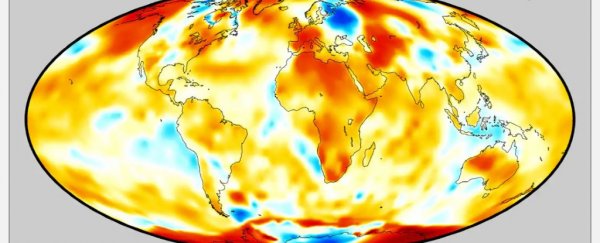Data from thousands of surface monitoring stations worldwide, including ocean buoys in the Pacific and land-based thermometers dotting the continents, show that July 2019 was the warmest month on Earth since at least 1850.
Berkeley Earth, an independent climate monitoring and research organization, released data Thursday showing last month beat August 2016 for the title of the warmest month by 0.14 degrees (0.08 Celsius).
"Though the margin is small, given the uncertainty range, we consider July 2019 to have set a new record for the highest monthly average temperature," the organization said in an analysis.
Previously, the European Union's Copernicus Climate Change Service had found that July 2019 was the warmest month on record, though by a small margin compared to its previous hottest month on record.
The NOAA also announced Thursday that July was the warmest month on record, with the global average surface temperature coming in at 1.71 degrees (0.95 Celsius) warmer than the 20th century average.
According to Deke Arndt, head of climate monitoring for NOAA, July 2019 marked the 415th straight month that was warmer than the 20th century average.
In keeping with accelerating global warming, nine of the 10 warmest Julys have occurred since 2005, NOAA found.
July brought extreme heat to Europe, and massive wildfires to the Arctic, including Alaska, Siberia and even Greenland, as well as a record and sudden melt event to the Greenland Ice Sheet.
During the European heat wave in late July, Sweden set a record for the warmest temperature observed in that country north of the Arctic Circle, NOAA reported, with a maximum temperature of 94.6 degrees (34.8 Celsius) in Markusvinsa on July 26.
At the end of the month, both Arctic sea ice and Antarctic sea ice were at their lowest levels on record for the month, missing a total of 1 million square miles of ice, according to NOAA. If this were a country, Arndt said, it would be the 10th largest nation worldwide.
What makes the July temperature record, as well as the year-to-date trajectory, stand out so much is that there is no longer an El Niño event in the tropical Pacific Ocean.
Such natural climate cycles feature warmer than average ocean temperatures that send extra heat into the atmosphere, boosting the planet's average temperature. A particularly strong El Niño during 2016 propelled that year to record levels, yet in 2019 there has only been a weak El Niño that recently dissipated entirely.
This demonstrates how, due to increased concentrations of greenhouse gases in the air from the burning of fossil fuels, the climate no longer needs a strong natural extra dose of warming in order to set a new temperature milestone.
"If you think about climate change as long-term gain on an escalator, kind of riding it up over time, and El Niño and La Niña kind of jumping up and down on that escalator," Arndt told reporters on a conference call.
He said the fact that July was in the vicinity of a record without a strong El Niño being present is "almost entirely due to climate change."
Ominously, Berkeley Earth found that July 2019 was 2.20 degrees (1.22 Celsius) warmer than the 1850 to 1900 average, which is often used as the baseline for preindustrial temperatures.
In the Paris climate agreement, world leaders committed to keeping long-term global average surface temperatures to "well below" 3.6 degrees (2 Celsius) compared to preindustrial levels, but they have not followed through on making the massive cuts to greenhouse gas emissions that are required to meet that goal. The United States shaped that agreement, but the Trump administration announced it would withdraw from it.
Berkeley Earth found that during July, 73 percent of the Earth's surface was "significantly warmer" than the 1951-1980 average, with just 5.9 percent of the globe significantly colder.
Warm areas that stood out include Alaska, Greenland, Europe, Africa, and parts of Asia and Antarctica. "We estimate that 4.7 percent of the Earth's surface set a new local record for the warmest July monthly average. In July 2019, no places on Earth experienced a record cold monthly average," the report states.
In addition, NASA found that July was 1.67 degrees (0.93 Celsius) above the 20th century average, making it the warmest July and "vies for the warmest month in absolute terms with August 2016" in its record.
Separately, the Japan Meteorological Agency also found July 2019 was the warmest month on record, though it was in a virtual tie with July 2016.
2019 is a lock for a top 5 warmest year
Berkeley Earth's analysis found that 2019 is unlikely to set a new record for the warmest year, largely because the January through May period was colder than the same period in 2016.
Instead, researchers found there is a 90 percent chance that 2019 will wind up as the second-warmest year since instrumental records began.
According to NOAA's Arndt, there's a 100 percent chance that 2019 winds up being a top-5 warmest year, and it will most likely be the 2nd, 3rd or 4th warmest year, depending how temperatures rank between August and December.
2019 © The Washington Post
This article was originally published by The Washington Post.
